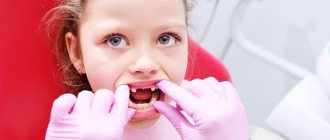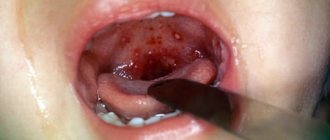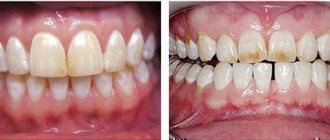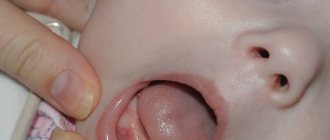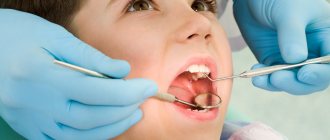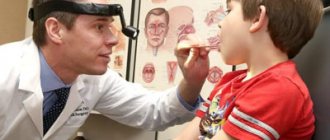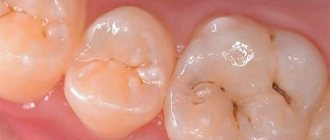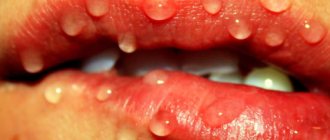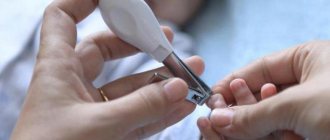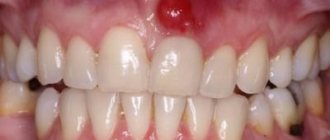What not to do?
Precautionary measures strictly observed by parents will help avoid unpleasant moments in the future.
Remember these simple rules and recommendations:
- In the first 2 months of life, it is better not to use soap during bathing;
- Sometimes adults make a big mistake by trying to squeeze out white pimples on their own. Doing this is strictly prohibited, because small wounds can easily become infected;
- Do not wipe acne areas with alcohol-containing liquids. This can cause severe irritation on delicate skin;
- You need to make sure that the baby doesn’t accidentally hurt himself by waving his arms in different directions. In the first days of life, babies cannot control the movement of their limbs. If you don’t want to tightly swaddle your baby in a diaper, then there should be special “mittens” made of soft fabric on the arms.
The baby needs to be bathed daily, thoroughly rinsing body folds and hard-to-reach areas with warm water. This measure is enough for the white dots to disappear in a short time. There is no need to use any creams, lotions or detergents.
White spots on a child's body: what are they?
White spots on a child’s skin may appear due to pathological processes occurring in the child’s body. Let's look at the four most well-known diseases:
- Vitiligo is a disease in which melanin cells in certain areas of the skin are destroyed at the genetic level. Often white spots appear on the face, hands, and knees.
- Hypomelanosis - occurs in newborns during the first two weeks of life, in which case they speak of a congenital skin disease caused by a lack of melanin. Melanin is a substance found in skin cells and is responsible for the color of skin, hair, and eyes. Hypomelanosis looks like a white patch of skin with clearly defined boundaries.
- Pityriasis rosea, or Zhiber's pityriasis, is formed as a result of a viral infection, reduced immunity, or allergies. It can appear on any part of the body, does not have smooth outlines, and the spots vary in size.
- Pityriasis versicolor - spots of different shades and sizes, located mainly in the upper part of the body: face, chest, back, neck, shoulders. The spots are characterized by peeling and itching.
Causes of white spots
A white spot that appears on a tooth in a child or an adult may be a sign of the initial stage of caries . But there are other, more serious reasons why these spots may appear. Next, they will be discussed in more detail.
Read also: What to do if a teenager’s teeth are crumbling
Initial stage of caries
Quite often, chalky white spots on a tooth signal the onset of caries. By and large, such a stain is an area of enamel that has become demineralized and represents an already damaged surface layer. During this period, the enamel in the affected areas becomes softer and rougher. This area of the tooth becomes dull , in contrast to healthy enamel, ceases to shine and therefore becomes visually noticeable.
Fluorosis is a process completely opposite to demineralization. It occurs when there is an excess of fluoride . It can occur for various reasons, including:
- frequent use of anti-caries pastes;
- work in hazardous industries;
- drinking water high in fluoride.
The last reason for the development of fluorosis is the most common and, as a rule, affects the child’s still fragile teeth . This disease can manifest itself in more than just white spots. Fluorosis has different forms:
- destructive;
- dashed;
- erosive;
- spotted;
- chalky-mottled.
This disease tends to appear gradually and has three main stages:
- Dashed (initial) - appears, as a rule, on the upper teeth in the form of a white stripe;
- The stripes begin to expand into spots . In a very young child, this stage appears immediately after teeth appear.
- At the last stage of development of fluorosis , the spots turn from white to brown, brown or yellow. The enamel on the affected teeth begins to wear off, and dentin may be exposed.
Such a manifestation of the disease in both a child and an adult cannot be ignored and left to chance. It is imperative to get rid of white spots at the initial stage and fluorosis itself. In the future, this disease will begin to affect not only the teeth, but will also lead to other serious problems:
Enamel hypoplasia
This disease can also be one of the reasons for the appearance of white spots on the tooth. The main reason for its development is impaired metabolic processes in the human body.
If such a problem appeared in a very young child, then, most likely, during pregnancy, his mother suffered from toxicosis or suffered from a viral disease. In this case, hypoplasia appears on the child's front baby teeth . If the disease appears on permanent teeth, it is necessary to examine the child and exclude the presence of possible diseases that could lead to metabolic disorders:
- chronic somatic diseases;
- brain diseases;
- toxic dyspepsia;
- infectious diseases;
- rickets.
Enamel hypoplasia can be determined by its main symptoms . These include:
- white, sometimes yellow, smooth tooth stains;
- pinpoint depressions may be observed on the enamel;
- there may be places on the tooth where there is no enamel at all;
- teeth take on a strange, unnatural shape.
Main reasons
Spots often appear in affected areas after wounds. If the injury was not deep, the pigment forms again after some time, i.e. white spots on the skin appear and disappear.
Deep and extensive damage can lead to permanent depigmentation.
Scars should be taken care of and special ointments should be used to speed up healing and minimize visible consequences.
Light spots can be one-sided or two-sided, i.e. appear on one or both legs. Individual localizations may vary in size and color - it can be from light pink to milky white. In any case, if white spots appear on your legs, you should consult a dermatologist. The reasons may be as follows:
- Vitiligo is a skin disease caused by a lack of melanin, the pigment that gives color to the skin. The cause of this disease is unknown, but experts believe it is an autoimmune disorder. Vitiligo can appear on any part of the skin.
- Pityriasis alba - This disease causes discoloration of the skin, most cases affecting young people and children. White spots on the skin of the legs may be accompanied by the presence of light localizations on other parts of the body (arms, face, etc.). The light areas in this condition are slightly raised (above the surface of the skin), rough, and prone to flaking. This condition is very worse in winter or in humid environments.
- Tinea versicolor ("sun pityriasis") is a fungal infection that predominates in hot, humid areas.
- Guttate hypomelanosis - occurs due to prolonged exposure to the sun or taking medications. With hypomelanosis, the spots have a clear outline, unlike vitiligo.
- Other causes include psoriasis or certain types of eczema, which can also cause white spots on the legs.
We invite you to familiarize yourself with the symptoms of skin cancer and methods of diagnosing it.
Known causes
Skin cells contain a special pigment called melanin, which is found deep within the skin. When melanocytes are destroyed for some reason, light spots form on the body. Such a flaw is very noticeable due to the contrast, especially in the warm season, when a tan appears. Light areas of the dermis can form for the following reasons:
- Low levels or complete absence of melanin. This happens as a result of suppression of the activity or death of melanocytes.
- Local circulatory disorders due to persistent vascular spasms.
- Modification of the dermis due to scars (atrophic formation).
- Due to the formation of a large number of crusts and scales on top of the skin lesion.
- As a result of damage to some disease caused by a fungal or other infection.
An unpleasant white spot on a child’s skin may appear due to one of the diseases described below:
- vitiligo;
- hypomelanosis;
- pityriasis versicolor;
- pink lichen of Zhiber;
- simple facial deprivation;
- white pityriasis.
This is not a complete, but the main list of diseases that cause whitish spots on children's skin.
Vitiligo
Vitiligo is a common disease that affects up to 30% of children. This depigmentation occurs due to the destruction of melanin and appears as light pink or white plaques. Most often the face, hands, and knees are affected. To the touch, the affected areas are smooth, without pronounced roughness, and do not rise above the skin. The main causes of vitiligo are considered to be: heredity, infection with worms, psychological trauma or stress, an infectious disease that the baby endured with difficulty. In most cases, the disease is not accompanied by pain, but some patients noted that itching appeared in the affected areas. A sick child suffers more morally due to the lack of a decent aesthetic appearance than physically. Parents should prepare for the fact that, regardless of the popularity of the disease, there is still no treatment that guarantees a 100% cure. In children affected by the age of 5 years, vitiligo is not treated, but only observed, tracking changes in size. It happens that after the baby’s immune system is fully formed, the spots disappear on their own. If treatment is unavoidable, then according to the doctor’s instructions, special ointments or creams are used, and if necessary, the patient undergoes ultraviolet irradiation. Read the article: Can vitiligo be cured?
White spot on the skin of a child due to hypomelanosis
Hypomelanosis often occurs in children aged two months or years and manifests itself as white plaques of a strange, ambiguous shape. The main reason for the appearance is a disease severely tolerated by the body, but besides this, there are other reasons. A dermatologist does not have the right to diagnose a child if he does not have the results of a histological examination, as well as other diagnostic procedures. Hypomelanosis poses a danger to children because it can affect the nervous system and, as a result, affect overall development. By the way, to this day, doctors have not been able to understand the mechanism of development of the disease and its inhibitory effect on the central nervous system. If you notice signs of hypomelanosis in your baby, you should urgently see a doctor, because it is much easier to cure in the initial form. For treatment, doctors prescribe retinoids, which slow down the rate of skin changes, as well as procedures that help exfoliate dried epidermal cells, such as peeling.
Pityriasis versicolor (lichen versicolor)
First of all, the disease manifests itself on the back, and then spreads to the neck, chest, and armpits. It appears as white scaly spots of round, oval or cylindrical shape. The affected areas are often itchy. At the same time, the lymph nodes enlarge. The cause of pityriasis versicolor is a fungal infection, so a doctor’s examination is required. In addition, it is contagious. Interesting article: How does lichen begin?
Pink lichen of Zhiber
This type of lichen is not contagious and appears as a result of one of the possible viral diseases. You can recognize it by a single large light pink spot, which is surrounded by small light dots. The causative agent of the disease is a fungal infection. The plaque characterizing Zhiber's lichen forms on any skin area of the body. To treat pityriasis rosea and pityriasis versicolor, an integrated approach is used, including shampoos, rubdowns, and antifungal ointments. A positive result is obtained by wiping the affected dermis with salicylic alcohol or apple cider vinegar. All the details: Pink lichen of Zhiber
Lichen simplex of the face
It has an abortive form of impetigo and belongs to the group of streptococcal pyodermatitis. The first indicator is light pink spots covered with a layer of small crusts located on the face area. The disease appears suddenly, especially in the summer after prolonged exposure to sunlight. You can get rid of lichen by following targeted treatment prescribed by a doctor, with local use of disinfectants.
White pityriasis
You can recognize it by its light, small, oval-shaped plaques. The favorite place to be affected is the face, but pityriasis can sometimes be found on the arms and upper body. It is observed in children 3–16 years old. Not contagious. The disease does not pose any threat to the life and health of the child. There are no uncomfortable sensations. True, a white spot on the skin of a child from birth due to pityriasis can confuse parents from two months to three years. To speed up the process of its disappearance, you should moisturize the affected area as often as possible.
What can be done to make the points pass faster?
“Why does a newborn have white spots on his nose?” - This is perhaps the most popular question from young parents. The main reason is a physiological process that occurs in every second child. By the age of two months, the baby’s skin will adapt to external environmental conditions and will be ideal, smooth, and without blemishes. The main thing during this period is not to squeeze pimples under any circumstances.
If, nevertheless, the white dots on the baby’s nose really bother you, you can suggest the following methods, which are unlikely to help, but certainly will not harm the child:
- Wipe the baby's nose after bathing with a weak solution of string or chamomile. The herb should be brewed according to the instructions on the package. Water should only be boiled. It is better to use a sterile bandage or sponge.
- Some doctors recommend bathing the baby in water with the addition of potassium permanganate. But remember, the color of the water should have a slightly pink tint. Excess of this solution can cause severe burns and allergic reactions on the baby’s delicate skin.
- Do not forget about basic hygiene rules; wash your child several times a day with boiled water.
Remember, white dots on a newborn’s nose, the photo of which is presented below, do not require any action at all. There is no need to treat them. Usually milia go away by the time the baby is two months old.
Adaptation rash in newborns
Do not forget that childbirth is a huge stress not only for the mother, but first of all for the baby, who also goes through a difficult period of adaptation after it. The baby needs to learn to eat independently, get used to the fact that you need to breathe air, and also learn to live not in amniotic fluid, but in a new, airy environment.
That is why small pimples sometimes appear on the skin, which, in principle, do not bother the baby. Pimples can look not only like white dots on the face of a newborn, but also reddish - in this case there is no reason for parents to worry.
They appear, as a rule, already on the second or third day after birth. But, if you are still worried and in doubt, then show the baby to a neonatologist, at least for your peace of mind.
White pimples on the face: causes
Parents should not be alarmed if they encounter white pimples on the face of their newborn child. They may appear as a result of the following reasons:
- as a physiological reaction of the baby’s adaptation to environmental conditions, resulting in a complete restructuring of the entire child’s body;
- a white pimple in a child as a result of an excess amount of the hormone estriol in a woman during pregnancy. Therefore, in the future, her baby may experience a similar type of rash, called neonatal bloom;
- unformed sebaceous glands, resulting in the appearance of white pimples - milia. Such acne does not require intervention and, as a rule, goes away after 1.5 months;
- acne can act as an allergic reaction to the mother's food if the child is breastfed. In this case, the nursing mother needs to adjust her diet.
We suggest that you familiarize yourself with the prognosis for ascites due to ovarian cancer
White pimples in newborns and infants. how to treat white pimples in children?
The skin of a newborn baby is extremely sensitive and reacts to absolutely everything - allergens, external irritants, hormones. One of the types of manifestations on the skin of a baby is white pimples on different parts of the body.
A woman’s life completely changes with the birth of a child, and, in addition to joy, the fair half of humanity is faced with a number of issues regarding the baby’s health.
One of them is the appearance of pimples in the baby.
It is not always possible to immediately figure out what caused the rash - the mother’s diet and an allergic reaction, or physiological processes in the developing and fragile body of the newborn.
Rashes on the face
Both acne and millet may appear on the baby's scalp. Blackheads typically do not itch or produce fluid. The places where hormonal acne appears are the cheeks, nose, forehead, chin, sometimes the ear and the hairy part of the head. They do not appear on the arm or leg.
If a newborn has white pimples on the skin of the eyelids, their causes may be:
- poor functioning of the sebaceous glands;
- contact with irritants (prolonged exposure to sunlight can also irritate the skin of an infant);
- lack of calcium at the time of teething.
Sometimes white pimples appear on the tongue and gums of a newborn. Their reasons may be:
- stomatitis due to infection in the baby’s mouth, and red pimples near the throat may be observed;
- thrush (characterized not by pimples, but by a white coating);
- pimples on the palate sometimes indicate dysbiosis.
Localization of white spots on the face in infants
Light-colored formations in newborns have different locations, it depends on the cause of their occurrence, the severity of skin damage, and the presence of inflammatory complications:
- milia are located in the area of the nose - on the wings, tip;
- with hormonal imbalance, single white dots on the face appear in the area around the newborn’s eyes, the rashes move from the bridge of the nose to the forehead, cheeks;
- a peculiarity of formations with streptococcal or staphylococcal lesions of the epidermis - pimples are localized on the chin, nose, temporal region, covering the scalp; purulent whiteheads can spread throughout the body.
Normally, the points do not transfer from the face to the mucous membranes of the lips, oral cavity, and eyes of the newborn. The appearance of rashes in this area indicates serious diseases of the immune system, the addition of dangerous bacteria with inflammation of pimples, purulent discharge.
A specialist - a dermatologist, pediatrician, or family doctor - can determine the main cause of white subcutaneous formations on the face and carry out diagnostic procedures and prescribe methods for treating spots in a newborn.
Prohibited actions
Of course, you want to quickly see the baby’s skin beautiful, ruddy, without white spots and unnecessary spots, and take as many photographs of the newborn as possible. This desire can lead to dangerous actions. Here's what not to do:
- Do not squeeze out white dots. This will not bring them closer to disappearance, but it can lead to infection, because newborn babies do not need much to catch some kind of disease. In addition, the child’s delicate skin is injured from such actions;
- It is prohibited to lubricate the baby’s facial skin with lotions containing alcohol. This can cause burns on the skin, and getting rid of them is much more difficult than white milia;
- Do not use iodine, brilliant green, or fatty creams. The former can also cause burns, and lubrication with cream leads to additional blockage of the sebaceous glands, which will only increase the time period during which the white spots will pass;
- Drying your skin with powder is also not a good idea;
- There is no need to give the newborn any medications; it is worth remembering that white milia are not a disease.
Read about what products you should have in your arsenal to care for a newborn in the article: First aid kit for a newborn>>>
Any interference in the physiological development of the body can harm the baby, so it is better to give up the desire to quickly make the skin of the face ideal, and allow the milia to disappear on their own.
In a couple of months, you will completely forget that your small nose was once decorated with white dots. Medicine knows several sad cases of treatment of white spots in newborns by overly caring parents. No positive effect was noticed as a result of self-medication, but there were enough negative consequences.
What does it look like?
Both very small white dots and larger white spots that resemble chalk may appear on a child’s teeth. They can be located both on the front or side surfaces of the teeth, and in the cervical region and on the tops of the crowns. There can be one white spot and be present on only one tooth, but there are also multiple white spots on several teeth.
Some children's teeth are covered with white stripes (strokes), which gradually increase in size and become stained. the process of demineralization of tooth enamel manifests itself and becomes less durable.
The main reasons for the appearance of white spots on children’s teeth are:
1. Damage to enamel by caries. The disease begins with the appearance of whitish spots on the surface of the teeth. This indicates the beginning of enamel destruction under the influence of bacteria that cause caries. As a rule, there are no other symptoms of the disease at this time. And this poses the greatest danger, since the stage of white spots in children quickly moves into the next stage, when the enamel is affected deeper and the infection reaches the dentin. In addition, if caries appears only as white spots, it is quite easy to cure without the need to use a drill and fillings.
2. Development of fluorosis. This is the name for a chronic disease caused by excess fluoride entering the body. Most often, this element comes from water, which contains it in excess (more than 1 mg per liter). Fluoride is an important element for teeth and if there is a lack of it, teeth will decay, but excess fluoride is also dangerous for teeth. An excessive concentration of fluoride in water will affect enamel cells and bind calcium salts in them. In addition, oversaturation of the body with fluoride is also dangerous for the thyroid gland.
With fluorosis, teeth become fragile, first covered with white stripes, then with white and brown spots, and erosions and areas of abrasion appear on the enamel surface. The disease is often diagnosed in schoolchildren on the front teeth. The disease first affects the upper dentition, and then spreads to the lower jaw. If left untreated, the child may develop serious dental and skeletal problems.
Read also: Which is better, a crown or a pin?
3. Enamel injury. A white spot on a tooth can appear as a result of a fall, bruise or any other mechanical impact on the enamel. Sometimes the injury does not appear immediately, but after months or even years. In addition, the enamel surface may become covered with white spots due to prolonged orthodontic treatment. If a child wears braces and braces for a long time, the adjacent teeth on which these devices are attached may be damaged.
4. Enamel hypoplasia. The disease is caused by metabolic disorders, as a result of which the tooth enamel is formed incorrectly and remains fragile and thin. The problem often appears at the age of 1.5-4 years, affecting baby teeth. Underdevelopment of enamel can be caused by problems with pregnancy (severe toxicosis or an infectious disease in the mother), rickets, acute infection, protein metabolism disorders, chronic illness in a child, hypovitaminosis, disruption of the central nervous system and other factors.
In addition to white smooth spots with hypoplasia, there will be pinpoint depressions and areas where there is no enamel on the surface of the teeth. In addition, with hypoplasia, the teeth are uneven and their shape is disrupted.
Parents who notice white spots on their baby's teeth should definitely contact a dentist. Such a symptom should not be left untreated in order to prevent deterioration of the enamel, as this can lead to the loss of baby teeth and problems with permanent bite. To eliminate white spots on the surface of teeth, methods must be used that address the cause of the white spots.
- In case of early caries, the doctor will clean the tooth surface and restore the enamel using special techniques, for example, fluoridation or treatment with calcium solutions.
- If the teeth are slightly injured (only the surface layer is damaged), they will be treated with special solutions to saturate the enamel with calcium. For deeper damage, tooth reconstruction is required.
- If white spots appear as a result of wearing braces or brackets, you should select a different model of device, clean the enamel and treat it, and then take special dental care measures during the period of orthodontic therapy.
- When fluorosis develops, predominantly local treatment is used, which is called remineralizing therapy. The teeth are treated with solutions containing phosphorus and calcium. Applications, photo- and electrophoresis are used for processing. If the damage has penetrated deeply, the damaged areas of the tooth are restored using fillings.
- If the cause is underdeveloped enamel, it will not be easy to help the child, since the process of hypoplasia is irreversible and medicine is not yet able to cure it. The teeth will be treated symptomatically, with enamel reconstruction.
When to see a doctor
White pimples in a newborn often appear on the face. By consulting a doctor and not self-medicating the points, you will be able to avoid negative consequences for the baby’s health.
Do you need advice from an experienced doctor? Get a doctor's consultation online. Ask your question right now.
Ask a free question
Dr. Komarovsky and domestic pediatricians recommend getting medical help if alarming symptoms occur:
- whiteheads do not disappear for a long time;
- the child is capricious, when pressing on the points, the newborn cries, which indicates discomfort, pain when touching the attributes on the face;
- there is dry skin, in the area of accumulation of milia - peeling or redness;
- increased body temperature due to rashes in a newborn;
- an increase in the size of white growths on the face; when an infection occurs, yellow purulent contents accumulate inside;
- in the first year of the baby’s life, the number of points increases;
- a hyperemic rim forms around the growths;
- White pimples on a child's face are caused by disorders of the digestive system and are accompanied by changes in stool, vomiting, and poor appetite.
We suggest you familiarize yourself with Pimples and other rashes on the labia of women: types, treatment, danger
Dots and rashes on the face are often a consequence of diseases of the newborn or a manifestation of disturbances in the functioning of the internal systems of the body. By undergoing a timely examination by a doctor, you can eliminate the pathology at an early stage of manifestation.
Recommendations from Dr. Zubastik
The child does not complain about anything, but have you noticed light spots on his teeth? Make an appointment with your dentist. If these are the first symptoms of the disease, it is easier to cope with it at an early stage. And if it’s just a structural feature of the enamel, the doctor will tell you about it and reassure you.
And most importantly: be sure to teach your child from a very early age how to properly brush his teeth. Oral care is his daily responsibility, he should know this. And to make it more interesting, make up fairy tales, stories with brush adventures and brush your teeth together. Then many problems can be avoided.
A short video about the rules of caring for your baby’s teeth:
Tags: White spots, braces, Baby teeth, nutrition
About the author: Dr. Zubastik
Typically, a toothache begins to subside on the way to the clinic and finally goes away after 10 minutes of sitting in line to see the dentist.
- Related Posts
- Nausea again... How to overcome the gag reflex when brushing your teeth?
- Plaque on children's teeth: should it be removed?
- How to get rid of black plaque on teeth in adults and children
« Previous entry
When should you see a doctor?
White dots on a baby's nose are a fairly popular phenomenon. But there are cases when, if they are detected, you must immediately consult a doctor:
- In addition to the dots that appeared on his face, the baby’s temperature rose sharply above 38.0 °C. Remember, in this case, no antipyretics should be given until consultation and the doctor’s arrival.
- Areas of skin appear red and inflamed.
- When touching pimples, the child reacts by crying, clearly making it clear that they are painful.
- Pimples contain pus or ichor inside.
- White dots are large in size.
- When acne appears, the child’s general condition changes (eats poorly, sleeps poorly, cries often, gets nervous).
In these cases, the appearance of white dots may indicate the onset of serious illnesses, so you cannot do without consulting a doctor.
How to get rid of stains that have appeared
As a result, it becomes clear that one of the symptoms that signal possible problems in the body may be the appearance of a white spot on the tooth. the real cause of the spot can tell you how to get rid of this problem . That is why, if white spots appear on a tooth, especially in a child, it is necessary to consult a doctor in any case. Depending on the diagnosis, treatment methods and how to get rid of stains may differ from each other.
Treatment of early caries
If caries is recognized as the cause of the problem, then it needs to be treated even on baby teeth. To eliminate the problem, the following procedures can be performed in the dental office:
Solving the problem of fluorosis
One of the main actions taken in case of fluorosis is constant monitoring of the intake of fluoride into the body of both the child and the adult. This control process can be facilitated by taking the following measures:
- use water filters;
- stop using fluoride-containing toothpastes;
- reduce the consumption of certain foods (eggs, fish, fatty meat, walnuts);
- Take vitamins and a variety of calcium and magnesium supplements.
Read also: Wisdom tooth cutting, what to do
These measures should be carried out at home, in everyday life, as additional measures. In dentistry, there are methods to combat fluorosis. They depend on the degree of development of the disease.
For spotted, streaked and chalky forms, remineralizing therapy is carried out. During this treatment, the tooth is saturated with the necessary phosphorus and calcium . Typically, remineralization occurs through procedures such as electrophoresis and photophoresis.
At all other, later stages, enamel restoration can only be done using composite materials.
Treatment and prevention of hypoplasia
Unfortunately, hypoplasia is recognized as an irreversible process . Its treatment is symptomatic and, as a rule, consists of reconstruction and cosmetic restoration of the enamel. To prevent its possible development in a child, during pregnancy it is recommended to adhere to the following tips:
- Avoid taking antibiotics as much as possible;
- do not use tetracycline drugs;
- eat well;
- provide adequate nutrition to the newborn.
If hypoplasia is detected in a child with baby teeth, it is recommended to carry out the procedure of silvering the teeth or covering them with a special protective agent. These measures are taken in order to save the child’s tooth until a permanent one appears in its place.
For both children and adults, if hypoplasia is detected, a special diet is recommended. It must saturate the body with calcium so that the destruction process does not progress.
Expert opinion
White growths on the skin of babies are a common occurrence. There are a number of criteria that indicate that parents should not hesitate to contact a pediatrician.
It is recommended to visit the clinic in the following cases:
- The newborn reacts negatively to any touch of the white spots. In this way he tries to inform his parents about pain and discomfort.
- The formations begin to noticeably increase in size. Pus and blood may also accumulate inside the milia. In this case, it is necessary to check the baby’s body for infection.
- Clear signs of inflammation appear around the white dots.
- The profuse rash goes away with a sharp increase in body temperature. In this case, the newborn constantly suffers from discomfort.
These symptoms are characteristic of a large number of serious diseases. In this case, only a doctor can make a correct diagnosis. If necessary, a medicinal course of treatment is prescribed. Other therapeutic measures also have a positive effect.
If inflammation appears around the milia, you should visit a doctor's office.
Are milia dangerous in a baby and when should you see a doctor?
If spots appear on the nose, cheeks, forehead, or eyes of a newborn, consult a doctor for diagnosis. The rash can be caused by physiological reasons or serious diseases.
White pimples caused by natural factors in the development of the body will go away on their own.
After a nine-month stay in the mother’s womb, the newborn needs to adapt to living conditions; as he adapts, the problem of the appearance of dots will no longer be a concern.
White formations on the nose may indicate that the baby has health problems. Seek medical help when observing symptoms in a child:
- there is a negative reaction of the newborn to touching areas of skin with light spots, indicating discomfort;
- an increase in the size of elements on the nose, accumulation of pus inside (a sign of an infection);
- the presence of redness and swelling in the area where white painful spots are located, which is a sign of an inflammatory process in a newborn;
- rashes on the baby’s nose are accompanied by an increase in body temperature.
Symptoms are characteristic of many diseases that require serious treatment. The doctor makes a diagnosis and prescribes treatment for white dots formed on the nose, which will ensure a speedy recovery of the newborn. Attempts by parents to independently diagnose the disease and carry out treatment are unacceptable: there is a risk of harm to health.
Reasons for the development of the disease
The main reasons why white spots appear on a baby’s skin are as follows:
- Viral infections have recently occurred.
- The disease is inherited.
- Hormonal imbalance.
- Malfunction of the thyroid gland.
- Autoimmune diseases.
As a rule, such spots appear without any symptoms, the body temperature does not rise, and they do not affect the baby’s well-being in any way.
The spots can be localized not only on the body, but also on the tongue. Moreover, in this case, the spots may indicate the following:
- Candida fungus - the disease manifests itself in the form of a white coating. The carrier of the disease is mainly the mother.
- Stomatitis is initially small white spots, after which liquid appears in them. The disease appears when there are wounds or infection.
If you notice white spots on your baby's body, you should definitely show him to the doctor.
How to deal with the disease?
If you have already identified the reason why white spots appear on the enamel of your child’s teeth, you can begin treatment. Of course, it is best to visit a dentist, but if this is not possible, you can try to cure yourself using traditional methods.
Traditional methods
It should immediately be noted that treatment with folk remedies for white spots on the enamel of teeth in a child, as well as in an adult, is possible only at the initial stage of the development of caries or fluorosis and under close monitoring of any changes.
It should also be taken into account that these measures are not applicable at any age, since in very young children they can cause discomfort or may simply be unacceptable at an early age.
Eating citrus fruits such as lemon and lime to help fight tooth decay. “Fruit” methods of control also include apples, which have a whitening effect.
Among herbal remedies, adherents of traditional medicine highlight:
- sage in the form of an infusion used for rinsing;
- propolis in the form of tincture (diluted, for rinsing) and compresses;
- laundry soap as a means for cleaning teeth;
- calamus tincture used for rinsing;
- fir oil , with which you can make lotions;
- Chinese lemongrass;
- mint in the form of an infusion for rinsing;
- garlic paste.
Traditional medicine attributes special properties in the fight against caries to onions and their peels , from which you can make an infusion for rinsing. A solution of sea salt is also suitable for rinsing.
There are a lot of options, including rubbing stove ash into the enamel .
However, dentists have a rather negative attitude towards such treatment methods, since no one can guarantee their effectiveness.
Each parent makes his own decision on how to deal with this problem, but it is important to remember that if there is no result or the slightest deterioration, it is necessary to contact a specialist as soon as possible.
Traditional treatment
The method of traditional treatment depends on the cause of the defect. If the appearance of white spots is caused by fluorosis, then therapy is carried out to reduce the amount of fluoride consumed.
This is done by avoiding toothpaste containing fluoride, as well as by following a diet that avoids water and foods high in fluoride.
it is not possible to cure it completely today .
Treatment consists of applying special compounds containing silver or fluoride to the teeth and helping to slow down the destruction of enamel.
It is very important to eat foods rich in calcium.
As for caries, it is very important to contact your dentist at an early stage, when the problem is reversible. It can be prevented by resorting to fluoridation or remineralization.
The latter is also effective in cases where the appearance of white spots on the teeth is associated with weak immunity . In this case, it is worth remembering about general strengthening agents and procedures for the body.
Most often, children develop black plaque on their teeth. Read more about this here.
First results
How quickly the treatment results will depend on the origin of the stains on the teeth and the method of treatment.
The fastest effect and visible results will be observed from procedures performed in a dental office, since they are aimed at solving the problem as quickly as possible.
Moreover, the compounds applied to the teeth are in direct contact with the enamel, and the compounds they contain penetrate it better and faster or protect it.
Correcting a defect with the help of diet requires a longer period of time, since everything here depends on the course of various metabolic processes and the absorption of certain substances by the body.
It is important to know here that if there is no effect or the disease progresses, you must consult a doctor in order to adjust the treatment in time and avoid irreversible consequences.
